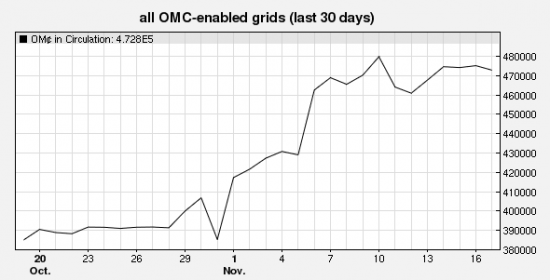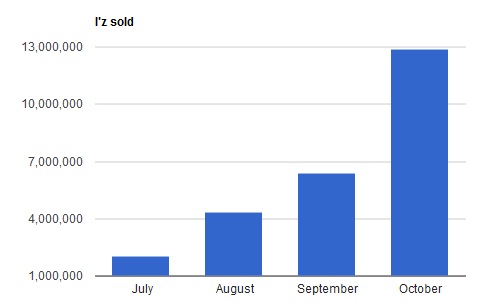The OpenSim economy continued to grow this month, with both the OMC currency and the I’z currency from InWorldz growing in users and transactions.
The OMC, a convertible currency from Austrian virtual currency exchange operator Virwox, is now accepted on 18 different grids — AnSky Grid, Avatar Hangout, FrancoGrid, GermanGrid, GiantGrid, Jamland, Logicamp, NorthGrid, OSgrid, Oneworld Grid, Reseau Oceax, Shiawase Grid, Open Neuland, Wilder Westen, Twisted Sky, UFS Grid, WorldSimTerra and Your Alternative Life.
Total OMC in circulation is now 472,800 OMC (US $1,682) — up from 382,537 OMC (US $1,331) one month ago, an increase of 24 percent.

Over the past month, 1,176 people were active using the currency, compared to 991 the preceding 30 days, an increase of 19 percent.

OMC has seen more takeup in the larger grids in the OpenSim universe since it was launched this past spring, partly because of solid backing from Virwox, one of the largest Linden dollar exchanges in Europe, and its lack of affiliation to any specific OpenSim grid or shopping platform.Virwox has traded over 4 billion Linden dollars (US$ 14.5 million) since it was founded in 2007.
In addition, the OMC is fully convertible to the US dollar, the Euro, and the Linden dollar, through a simple Web interface.
The OMC is hypergrid-enabled. Users with a balance in their OMC account will see that balance displayed in their viewers whenever they are on an region with OMC activated. That balance will stay with the users even as they hypergrid teleport from one grid to another and allows users to buy products on one grid and bring them home to their own grids.
A competing currency, the G$, is also hypergrid-enabled. According to parent company CyberCoinBank, the G$ can currently be used on eight grids — Avatar Hangout, Second Life, AnSky Grid, OS Grid, Virtual Highway, Meta7, InWorldz and Alpha Towne.
Since the G$ and the OMC use different systems, both currencies can be used on the same grid.
CyberCoinBank does not publish transaction or user information for the G$ currency, and the company has not yet responded to our requests for recent data. Last month, however, it reported 112 million G$ (US $448,000)Â in circulation in seven OpenSim grids, across Second Life, and in private role playing and gaming grids.
InWorldz currency purchases double
Meanwhile, the fastest-growing commercial grid on OpenSim, InWorldz, has begun reporting total purchases of its on-grid I’z currency.
In October, InWorldz sold 12,906,500 I’z (US$25,813), an increase of 102 percent from September’s 6,384,250 I’z (US$12,768).
While the currency can only be used on the InWorldz grid, the amount of new I’z sold in October is more than 15 times the total OMC in circulation.
InWorldz also gained more then 3,000 new users over the past month, more than any other grid on the OpenSim platform.
InWorldz has become a popular destination for virtual retailers because the grid is not on the hypergrid, and region exports are restricted. As a result, it is more difficult for people to take content from InWorldz to other grids, adding a level of security for content producers. In addition, InWorldz has an excellent reputation for support and customer service (see our latest poll of grid users here).

Like the OMC, the I’z is a redeemable currency. In October, residents cashed out $17,729 worth of I’z, according to InWorldz co-founder Beth Reischl, who is also known as Elenia Llewellyn in-world.
Buyer beware
One possible obstacle hindering the growth of the OMC currency is that there there is no simple way to resolve disputes.
For example, if a merchant takes your money on InWorldz and doesn’t give you your purchase in return, you can complain to the grid owners and they’re likely to step in and make things right — or ban the merchant from the grid if there’s a large number of complaints.
Grid owners can step in because they control the land and the currency. On other grids, however, the dispute mechanism can be less clear, or even non-existent — and buyers are on their own. In particular, if a merchant users a third-party, multi-grid currency, there is only so much that grid owners can do to mediate disputes even if they wanted to.
Grid owners also can’t guarantee the safety of outside currencies.
“We have no association to any third party programs and we have no idea how they handle security or have any way to audit their code or systems,” said OSGrid president Michael Cerquoni, also known as Nebadon Izumi in-world.
Finally, open grids such as OSGrid — which allow anyone to connect regions — have less control over the land on their grids than closed, commercial grids do. On a closed, commercial grid, regions owners have to rent regions from the grid itself, provide payment information, and be required to comply with a Terms of Service agreement.
“We will not endorse or recommend usage of any commerce platforms in any open grids,” said Cerquoni.
Here at Hypergrid Business, we recommend that shoppers make their purchases only on trusted grids and stick to commercial grids where grid owners can exercise some control over the merchants. For G$, for example, the Alpha Towne grid managers will step in and help resolve disputes, according to CyberCoinBank founder and Alpha Towne grid operator Frank Corsi.
For OMC purchases, both Wilder Westen and German Grid are commercial grids that exercise direct control over all their regions.
- OSgrid back online after extended maintenance - April 16, 2025
- Analysts predict drop in headset sales this year - March 25, 2025
- OSgrid enters immediate long-term maintenance - March 5, 2025
